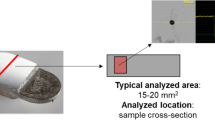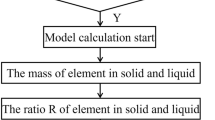Abstract
In the cobalt oxalate synthesis process in cobalt hydrometallurgy, the key end-product quality index, average particle size of cobalt oxalate, needs to be monitored and controlled. It is difficult to measure such particle size online by existing hardware sensors. Soft sensor technique has been widely used for estimating product quality or other important variables when online instruments and sensors are not available. In this paper, a hybrid modeling approach for cobalt oxalate synthesis process in cobalt hydrometallurgy is proposed by combining simplified first principle model with stacked LSSVR model. The former based on population balance equations and mass conservation equation with some assumptions is used for description and analysis of synthesis process in general; and the latter is developed to compensate the unmodeled characteristic and to enhance model generalization capability. Furthermore, a model output offset compensation strategy is also employed to increase the model prediction accuracy. Applications to a cobalt hydrometallurgy pilot plant demonstrate that the proposed approach is more precise and effective than the other conventional models.






Similar content being viewed by others
References
Zhang GP, Rohani S (2003) On-line optimal control of a seeded batch cooling crystallizer. Chem Eng Sci 58:1887–1896
Rawlings JB, Miller SM, Witkowski WR (1993) Model identification and control of solution crystallization processes: a review. Ind Eng Chem Res 32:1275–1296
Ma DL, Tafti DK, Braatz RD (2002) Optimal control and simulation of multidimensional crystallization processes. Comput Chem Eng 26:1103–1116
Fujiwara M, Nagy ZK, Chew JW, Braatz RD (2005) First-principles and direct design approaches for the control of pharmaceutical crystallization. J Process Control 15:493–504
Costa CBB, Costa AC, Filho RM (2005) Mathematical modeling and optimal control strategy development for an adipic acid crystallization process. Chem Eng Process 44:737–753
Park MJ, Dokucu MT, Doyle III FJ (2004) Regulation of the emulsion particle size distribution to an optimal trajectory using partial least squares model-based predictive control. Ind Eng Chem 43:7227–7237
Doyle III FJ, Harrison CA, Crowley TJ (2003) Hybrid model-based approach to batch-to-batch control of particle size distribution in emulsion polymerization. Comput Chem Eng 27:1153–1163
Sridhar DV, Seagrave RC, Bartlett EB (1996) Process modelling using stacked neural networks. AIChE J 42:2529–2539
Zhang J, Morris AJ, Martin EB, Kiparissides C (1997) Inferential estimation of polymer quality using stacked neural networks. Comput Chem Eng 21:s1025–s1030
Ahmad Z, Zhang J (2006) Combination of multiple neural networks using data fusion techniques for enhanced nonlinear process modelling. Comput Chem Eng 30:295–308
Suykens JAK, Vandewalle J (1999) Least squares support vector machine classifiers. Neural Process Lett 9293–9300
Suykens JAK, Van Gestel T, De Brabanter J, De Moor B, Vandewalle J (2002) Least squares support vector machines. World Scientific, Singapore
Perrone MP, Cooper LN (1993) When networks disagree: ensemble methods for hybrid neural networks. In: Mammone RJ (eds) Artificial neural networks for speech and vision. Chapman & Hall, New York, p. 126–142
Mukherjee A, Zhang J (2008) A reliable multi-objective control strategy for batch processes based on bootstrap aggregated neural network models. J Process Control 18:720–734
Braatz RD (2002) Advanced control of crystallization processes. Ann Rev Control 26:87–99
Ma Z, Merkus HG, van der Veen HG, Wong M, Scarlett B (2001) On-line measurement of particle size and shape using laser diffraction. Part Part Syst Charact 18:243–247
Hukkanen EJ, Braatz RD (2003) Measurement of particle size distribution in suspension polymerization using in situ laser backscattering. Sens Actuators B 96:451–459
Puel F, Févotte G, Klein JP (2003) Simulation and analysis of industrial crystallization processes through multidimensional population balance equations. Part 1: a resolution algorithm based on the method of classes. Chem Eng Sci 58:3715–3727
Marchal P, David R, Klein JP, Villermaux J (1988) Crystallization and precipitation engineering-I. An efficient method for solving population balance in crystallization with agglomeration. Chem Eng Sci 43:59–67
Mu SJ, Zeng YZ, Liu RL, Wu P, Su HY, Chu J (2006) Online dual updating with recursive PLS model and its application in predicting crystal size of purified terephthalic acid (PTA) process. J Process Control 16:557–566
Breiman L (1996) Bagging predictors. Mach Learn 24:123–140
Mesbah A, Landlust J, Huesman AEM, Kramer HJM, Jansens PJ, Van den Hof PMJ (2010) A model-based control framework for industrial batch crystallization processes. Chem Eng Res Des 88:1223–1233
Acknowledgments
This work was supported by the National High Technology Research and Development Program of China (No. 2011AA060204), National Natural Science Foundation of China (Nos. 61074074, 61174130 and 61004083), Project 973 of China (No. 2009CB320601) and the Fundamental Research Funds for the Central Universities (No. N100604008).
Author information
Authors and Affiliations
Corresponding author
Rights and permissions
About this article
Cite this article
Zhang, S., Wang, F., He, D. et al. Soft sensor for cobalt oxalate synthesis process in cobalt hydrometallurgy based on hybrid model. Neural Comput & Applic 23, 1465–1472 (2013). https://doi.org/10.1007/s00521-012-1096-x
Received:
Accepted:
Published:
Issue Date:
DOI: https://doi.org/10.1007/s00521-012-1096-x




